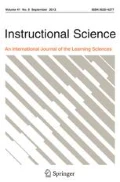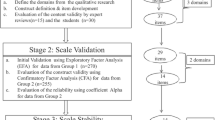Abstract
A major assumption of problem-based learning (PBL) is that learning issues, generated by students while discussing a problem, are used as guides for self-directed learning activities. This assumption, though basic to PBL, has never been tested. At the University of Limburg, the Netherlands, two procedures have been developed that reflect the extent to which students are able to identify important learning issues given a particular problem, and whether subsequent, independent, learning corresponds with these learning issues. The focus of the present article will be on the relationship between the two. We have explored to what extent student-generated learning issues are a major factor influencing the nature of students' self-study, or whether other factors may be involved in decisions on what to study and how much time to spend on topics selected. First, the production of learning issues was studied and represented as the percentage of overlap between learning issues raised by students and pre-set faculty objectives for each problem. The second procedure consisted of the administration of a ‘Topic Checklist’ (TOC) which purports to measure students' actual self-directed learning activities. The TOC consists of a list of topics specifying the intended course content. Students were asked to indicate on a five-point Likert scale how much time they had spent studying each topic and to what degree they had mastered that topic. Third, learning issues and TOC topics were compared directly in a qualitative sense. Comparisons between the procedures revealed that a low proportion of variance of TOC scores could be predicted from the percentage of faculty objectives identified for each problem and the direct match between learning issues and TOC scores. It is concluded that scrutinizing student-generated learning issues and topics covered during self-study may provide information about what content is covered by students in tutorial groups. The discrepancy between the results of the measurements suggests, however, that learning issues produced during group discussion are not the sole source on which students base self-study decisions. Several other factors may be involved, such as tutor guidance, content already covered in previous units, issues raised during sessions with resource persons, and the nature of the learning resources available. Therefore, the relationship between learning issues and content covered during self-study is not as straightforward as is suggested.
Similar content being viewed by others
References
Association of American Medical Colleges. (1984).Physicians for the Twenty-First Century. Washington, DC.
Barrows, H.S. & Tamblyn, R.M. (1980).Problem-based Learning. An Approach to Medical Education. New York: Springer.
Barrows, H.S. (1985).How to Design a Problem-basedCurriculumfor Preclinical Years. New York: Springer.
Blumberg, P. & Michael, J.A. (1992). Development of self-directed learning behaviors in a partially teacher-directed problem-based learning curriculum.Teaching and Learning in Medicine 4(1): 3–8.
Bruner, J.S. (1971).Towarda Theory of Instruction. Cambridge: Harvard University Press.
Dolmans, D.H.J.M., Gijselaers, W.M., Schmidt, H.G. & Van derMeer, S.B. (1993). Problem effectiveness in a course using problem-based learning.Academic Medicine 68(3): 207–213.
Dolmans, D.H.J.M., Gijselaers, W.H. & Schmidt, H.G. (1993). Course content coverage as a measure of instructional quality.Evaluation & the Health Professions 16(4): 448–471.
Eagle, C., Jennet, P. & Mandin, H. (1992). Learning issues identified using standardized patients in a problem-based learning course.Annals of Community-Oriented Education 5: 269–279.
Gettinger, M. (1984). Individual differences in time needed for learning: A review of literature.Educational Psychologist 19(1): 15–29.
Glaser, R (1991). The maturing of the relationship between the science of learning and cognition and educational practice.Learning and Instruction 1: 129–144.
Norman, G.R. & Schmidt, H.G. (1992). The psychological basis of problem-based learning: A review of the evidence.Academic Medicine 67: 557–565.
Schmidt, H.G. (1983). Problem-based learning: Rationale and description.Medical Education 17: 11–16.
Walton, H.J. & Matthews, M.B. (1989). Essentials of problem-based learning.Medical Education 23: 542–558.
Author information
Authors and Affiliations
Rights and permissions
About this article
Cite this article
Dolmans, D.H.J.M., Schmidt, H.G. & Gijselaers, W.H. The relationship between student-generated learning issues and self-study in problem-based learning. Instr Sci 22, 251–267 (1994). https://doi.org/10.1007/BF00891779
Issue Date:
DOI: https://doi.org/10.1007/BF00891779



